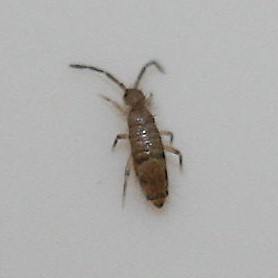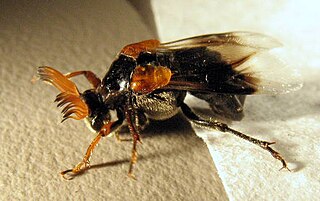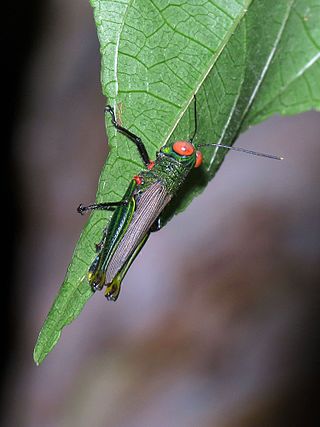
Ensifera is a suborder of insects that includes the various types of crickets and their allies including: true crickets, camel crickets, bush crickets or katydids, grigs, weta and Cooloola monsters. This and the suborder Caelifera make up the order Orthoptera. Ensifera is believed to be a more ancient group than Caelifera, with its origins in the Carboniferous period, the split having occurred at the end of the Permian period. Unlike the Caelifera, the Ensifera contain numerous members that are partially carnivorous, feeding on other insects, as well as plants.

The Caelifera are a suborder of orthopteran insects. They include the grasshoppers and grasshopper-like insects, as well as other superfamilies classified with them: the ground-hoppers (Tetrigoidea) and pygmy mole crickets (Tridactyloidea). The latter should not be confused with the mole crickets (Gryllotalpidae), which belong to the other Orthopteran sub-order Ensifera.

Entomobryidae, sometimes called "slender springtails", is a family of springtails characterised by having an enlarged fourth abdominal segment and a well-developed furcula. Species in this family may be heavily scaled and can be very colourful. The scale-less Entomobryidae are commonly caught in pitfall traps around the planet, and also occur in canopy faunas high up in trees. There are more than 1700 described species in Entomobryidae.

Ripiphoridae is a cosmopolitan family of some 450 described species of beetles sometimes called "wedge-shaped beetles". Ripiphoridae are unusual among beetle families in that many species are hypermetamorphic parasitoids, an attribute that they share with the Meloidae. Members of the family differ in their choice of hosts, but most attack various species of bees or wasps, while some others attack cockroaches or beetles. Many species of Ripiphoridae have abbreviated elytra, and flabellate or pectinate antennae.

Tetrigidae is an ancient family in the order Orthoptera, which also includes similar families such as crickets, grasshoppers, and their allies. Species within the Tetrigidae are variously called groundhoppers, pygmy grasshoppers, pygmy devils or "grouse locusts".

Gryllacrididae are a family of non-jumping insects in the suborder Ensifera occurring worldwide, known commonly as leaf-rolling crickets or raspy crickets. The family historically has been broadly defined to include what are presently several other families, such as Stenopelmatidae and Rhaphidophoridae, now considered separate. As presently defined, the family contains two subfamilies: Gryllacridinae and Hyperbaeninae. They are commonly wingless and nocturnal. In the daytime, most species rest in shelters made from folded leaves sewn with silk. Some species use silk to burrow in sand, earth or wood. Raspy crickets evolved the ability to produce silk independently from other insects, but their silk has many convergent features to silkworm silk, being made of long, repetitive proteins with an extended beta-sheet structure.
Chathamiidae is a family of case-making caddisflies more commonly known as the marine caddisflies. Chathamiids are unusual among insects in their invasion of the tide pool environment. Larvae construct their cases of coralline algae. The eggs of one marine caddisfy species are found inside starfish. The five described species are distributed along the coasts of New Zealand, New South Wales, and the Chatham Islands.

Tympanophora is a genus of bush-crickets, known as balloon-winged katydids, found in Australia. It is the only extant (living) genus in the subfamily Tympanophorinae.

Acrididea including the Acridomorpha is an infraorder of insects that describe the grasshoppers and ground-hoppers. It contains a large majority of species in the suborder Caelifera and the taxon Acridomorpha may also be used, which excludes the Tetrigoidea. Both names are derived from older texts, such as Imms, which placed the "short-horned grasshoppers" and locusts at the family level (Acrididae). The study of grasshopper species is called acridology.
Tettigoides is an extinct genus of katydids containing a single species, Tettigoides pectinata. It is the only genus and species in the subfamily Tettigoidinae. It is known from Ypresian aged deposits near Dinmore, Queensland, Australia.

Morabidae is a family of grasshoppers in the order Orthoptera. There are more than 40 genera and 120 described species in Morabidae, found in Australasia.
Locustavidae is an extinct family of grasshoppers in the order Orthoptera. There are about 6 genera and 12 described species in Locustavidae, with fossils found in Australia, China, Kyrgyzstan, and Russia.
Anelcanidae is an extinct family of long-horned Orthoptera. There are at least two genera and two described species in Anelcanidae.
Protogryllidae is an extinct family of crickets in the order Orthoptera. There are about 8 genera and more than 20 described species in Protogryllidae.
Tcholmanvissiidae is an extinct family of Orthoptera. There are at least two genera and about eight described species in Tcholmanvissiidae.
Tettoedischiidae is an extinct family of Orthoptera. There are at least two genera and two described species in Tettoedischiidae.
Xyronotidae is a family of Central American grasshoppers in the order Orthoptera. There are at least two genera and four described species in Xyronotidae.

Austroperlidae is a family of stoneflies in the order Plecoptera. There are about 10 genera and 15 described species in Austroperlidae across southern land masses Australia, New Zealand, and South America.Austroperlidae species are unique among stoneflies in having aposematic (warning) colouration. For instance, the New Zealand black stonefly Austroperla is a forest dwelling shredder that is toxic to predators due to its production of hydrogen cyanide. The warning colouration of this species is mimicked by several lineages of the unrelated non-toxic New Zealand stonefly Zelandoperla.

Proctolabinae is a subfamily of grasshoppers in the family Acrididae. There are more than 20 genera and 210 described species which are found in South America.

Wētā is the common name for a group of about 100 insect species in the families Anostostomatidae and Rhaphidophoridae endemic to New Zealand. They are giant flightless crickets, and some are among the heaviest insects in the world. Generally nocturnal, most small species are carnivores and scavengers while the larger species are herbivorous. Although some endemic birds likely prey on them, wētā are disproportionately preyed upon by introduced mammals, and some species are now critically endangered.











